生命周期评价案例1
H456运营管理-13_Case Analysis(1)
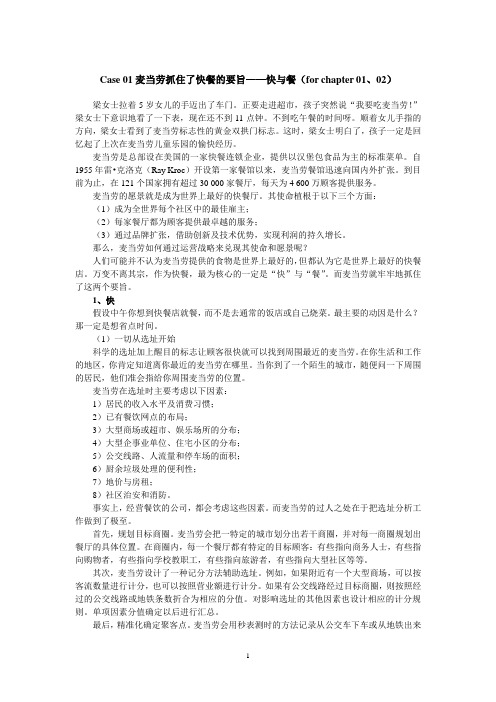
Case 01麦当劳抓住了快餐的要旨——快与餐(for chapter 01、02)梁女士拉着5岁女儿的手迈出了车门。
正要走进超市,孩子突然说“我要吃麦当劳!”梁女士下意识地看了一下表,现在还不到11点钟。
不到吃午餐的时间呀。
顺着女儿手指的方向,梁女士看到了麦当劳标志性的黄金双拱门标志。
这时,梁女士明白了,孩子一定是回忆起了上次在麦当劳儿童乐园的愉快经历。
麦当劳是总部设在美国的一家快餐连锁企业,提供以汉堡包食品为主的标准菜单。
自1955年雷•克洛克(Ray Kroc)开设第一家餐馆以来,麦当劳餐馆迅速向国内外扩张。
到目前为止,在121个国家拥有超过30 000家餐厅,每天为4 600万顾客提供服务。
麦当劳的愿景就是成为世界上最好的快餐厅。
其使命植根于以下三个方面:(1)成为全世界每个社区中的最佳雇主;(2)每家餐厅都为顾客提供最卓越的服务;(3)通过品牌扩张,借助创新及技术优势,实现利润的持久增长。
那么,麦当劳如何通过运营战略来兑现其使命和愿景呢?人们可能并不认为麦当劳提供的食物是世界上最好的,但都认为它是世界上最好的快餐店。
万变不离其宗,作为快餐,最为核心的一定是“快”与“餐”。
而麦当劳就牢牢地抓住了这两个要旨。
1、快假设中午你想到快餐店就餐,而不是去通常的饭店或自己烧菜。
最主要的动因是什么?那一定是想省点时间。
(1)一切从选址开始科学的选址加上醒目的标志让顾客很快就可以找到周围最近的麦当劳。
在你生活和工作的地区,你肯定知道离你最近的麦当劳在哪里。
当你到了一个陌生的城市,随便问一下周围的居民,他们准会指给你周围麦当劳的位置。
麦当劳在选址时主要考虑以下因素:1)居民的收入水平及消费习惯;2)已有餐饮网点的布局;3)大型商场或超市、娱乐场所的分布;4)大型企事业单位、住宅小区的分布;5)公交线路、人流量和停车场的面积;6)厨余垃圾处理的便利性;7)地价与房租;8)社区治安和消防。
事实上,经营餐饮的公司,都会考虑这些因素。
家庭生活周期[5篇]
![家庭生活周期[5篇]](https://img.taocdn.com/s3/m/e809261403020740be1e650e52ea551810a6c910.png)
家庭生活周期[5篇]以下是网友分享的关于家庭生活周期的资料5篇,希望对您有所帮助,就爱阅读感谢您的支持。
第1篇家庭生活周期是指家庭经历从结婚、生产、养育儿女到老年的各个阶段连续的过程。
在家庭的发展过程中,杜瓦尔(Duvall)认为家庭生活周期主要分为8个阶段。
家庭在每个阶段都有其特有的角色、责任及需求。
1.新婚期从结婚到第一个孩子出生前;其主要任务是双方相互沟通、适应,协调性生活及计划生育。
2.生产期第一个孩子介于0~30个月之间;其主要任务是调整进人父母角色,应对经济和照顾孩子的压力。
3.学龄前第一个孩子介于30个月~6岁之间;其主要任务是抚育孩子。
4.学龄期第一个孩子介于6~13岁之间;其主要任务是教育孩子,确保孩子的身心健康发育。
5.青少年第一个孩子介于13~20岁之间其主要任务是增进对孩子的了解、沟通。
6.年轻人第一个孩子离家至最小孩子离家之间;其主要任务是继续为孩子提供支持,同时逐步调整自己,以适应环境的改变。
7.中年期从所有孩子离家至退休;其主要任务是巩固婚姻关系,计划退休生活。
8.老年期从退休至死亡;其主要任务是应对疾病的来临及配偶、朋友的丧失。
在提供社区护理服务时,社区护士应针对家庭所处生活周期的特点,满足其具体需求。
第2篇家庭生命周期家庭是社会生活的基本单位,具有相当的稳定性、持久性和连续性。
家庭作为一个群体担当着组织家庭成员分工合作、生产、消费、养育子女、赡养老人等各项重要功能。
任何一个家庭,都有自己从建立、发展到解体和消亡的过程。
就家庭而言,从一对夫妻结婚建立家庭生养子女(家庭形成期)、子女长大就学(家庭成长期)、子女独立和事业发展到巅峰(家庭成熟期)、夫妻退休到夫妻终老而使家庭消灭(家庭衰老期),就是一个家庭的生命周期。
家庭生命周期,指的是一个家庭诞生、发展直至消亡的运动过程,它反映了家庭从形成到解体呈循环运动的变化规律。
在家庭生命周期的各个阶段有不同的家庭角色要扮演,不同的角色扮演有着不同的角色期待,而随着时光流逝,年岁渐增,个人观念因受外在环境影响亦不断改变。
产品生命周期成本(Day4-1)

Where is beef?•售價=成本+ 利潤+•利潤=售價–成本•成本=售價–利潤产品的生命周期•产品生命周期是指产品从“孕育”到“消亡”的全过程,包括产品研究和初“消亡”的全过程包括产品研究和初始设计、产品开发和测试、生产、销售、顾客使用和废置。
•生命周期成本(Life—cycled Costing)产品生命周期成本(LCC)是指在产品经济有效使用期间,从产品研究开发阶段开始,经过产品规划、设计、制造、售段开始经过产品规划设计制造售后服务等阶段,按每一阶段累计其发生的全部成本的总和.LCC分析的目的•评估和优化系统生命周期费用,以满足客户和系统需求系统需求。
应包括•为系统生命周期各阶段决策提供输入为系统命周期各阶段决策提供输入•在LC内,确定系统主要费用因素,评估所需要的花费项目•在系统设计方案选择中,透过费用的比较,选择较合适的、合理的设计方法•得到客户投资决定•预测未来运行费用减少风险提高•减少风险,提高LCC评价的准确性•提高投资效益LCC控制的意义1.完整性LCC补充了传统成本法下未曾核算的全部CC内容,即补充了或有负债成本,保证了产品成本项目的完整性。
成本项目的完整性2.符合收入与费用的配比原则和权责发生制符合收与费用的配原则和权责发制的原则LCC计算出的产品成本真实地反映了产品所发生的真正的劳动耗费.便于企业根据真实的成本资料进行生产经营决策,挖掘内部潜成本力,降低。
3.有效降低LCC,可以提高产品的竞争力有效降低LCC产命期成本()产品全生命周期成本(LCC)(1)开发设计阶段:研究开发新产品、新技术、新工艺所发生的新产品设计费工艺规程制定费设备调所发生的新产品设计费、工艺规程制定费、设备调试费、原材料和半成品试验费等。
(2)生产制造阶段:在生产采购过程中所发生的料、工、在生产采购过程中所发生的料工费及由此所引发的环境成本等社会责任成本。
(3)使用维护阶段:运行费+维护费+保障费,包括产品的使用成本和维护成本。
职业生涯规划案例分析(一))
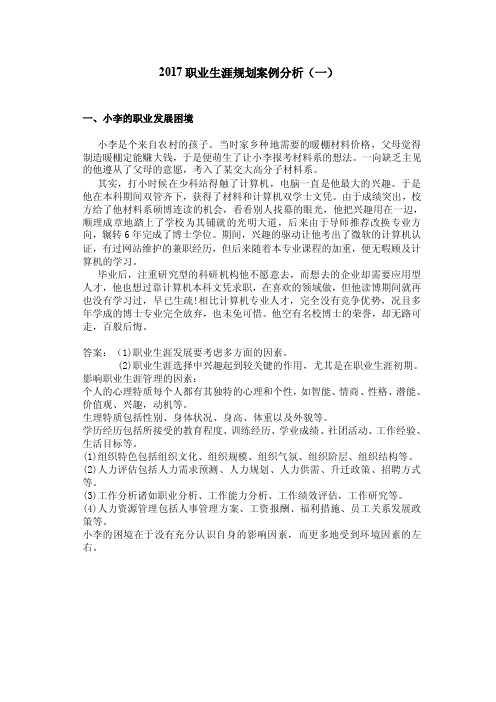
2017职业生涯规划案例分析(一)一、小李的职业发展困境小李是个来自农村的孩子。
当时家乡种地需要的暖棚材料价格,父母觉得制造暖棚定能赚大钱,于是便萌生了让小李报考材料系的想法。
一向缺乏主见的他遵从了父母的意愿,考入了某交大高分子材料系。
其实,打小时候在少科站得触了计算机,电脑一直是他最大的兴趣。
于是他在本科期间双管齐下,获得了材料和计算机双学士文凭。
由于成绩突出,校方给了他材料系硕博连读的机会,看看别人找幕的眼光,他把兴趣用在一辺,顺理成章地踏上了学校为其铺就的光明大道,后来由于导师推荐改换专业方向,辗转6年完成了博士学位。
期间,兴趣的驱动让他考出了微软的计算机认证,有过网站维护的兼职经历,但后来随着本专业课程的加重,便无暇顾及计算机的学习。
毕业后,注重研究型的科研机构他不愿意去,而想去的企业却需要应用型人才,他也想过靠计算机本科文凭求职,在喜欢的领域做,但他读博期间就再也没有学习过,早已生疏!相比计算机专业人才,完全没有竞争优势,况且多年学成的博士专业完全放弃,也未免可惜。
他空有名校博士的荣誉,却无路可走,百般后悔。
答案:(1)职业生涯发展要考虑多方面的因素。
(2)职业生涯选择中兴趣起到较关键的作用,尤其是在职业生涯初期。
影响职业生涯管理的因素:个人的心理特质每个人都有其独特的心理和个性,如智能、情商、性格、潜能、价值观、兴趣,动机等。
生理特质包括性别、身体状况、身高、体重以及外貌等。
学历经历包括所接受的教育程度、训练经历、学业成绩、社团活动、工作经验、生活目标等。
(1)组织特色包括组织文化、组织规模、组织气氛、组织阶层、组织结构等。
(2)人力评估包括人力需求预测、人力规划、人力供需、升迁政策、招聘方式等。
(3)工作分析诸如职业分析、工作能力分析、工作绩效评估,工作研究等。
(4)人力资源管理包括人事管理方案、工资报酬、福利措施、员工关系发展政策等。
小李的困境在于没有充分认识自身的影响因素,而更多地受到环境因素的左右。
《管理信息系统》案例及答案(1)_OK
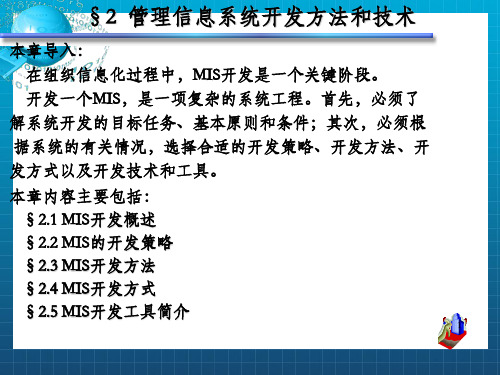
运行原型系统
提出意见 否
是
是
增加新功能否
否 完成系统开发并交付使用
修改
18
原型法优缺点: 优点:能够运用先进开发工具快速构造原型,缩短开发周期,
容易开发出用户满意的系统。适合小系统、DSS等。 缺点:开发前没有经过严格论证,可能出现原型的报废,造
成浪费;对软件工具要求较高;易造成文档的缺乏。 不适合开发大型系统,因为返工现象特别严重。
三、面向对象的方法(Object Orient Method,OOM) 面向对象方法是近年来兴起的一种新方法,它为MIS的开发 提供了一种新思路。 该方法将MIS看作是由一起工作来完成某项任务的相互作用 的对象的集合。 有关概念 对象:是对客观世界中事物实体的抽象。每个实体即称之
为对象。软件中的对象是一个封闭体,它由一组数 据和施加于这些数据上的一组操作构成。
2、“自上而下” (“自顶向下”,TOP-DOWN)的开发策略
基本思想:从整体上协部分,从而构建
系
统整体。
8
即:从MIS总体出发,从整体上确定MIS的功能、模块构 成以及之间的关系,在此基础上构建一个个子系统, 进而构建MIS总体。
3、两种策略之比较: “自上而下”策略:
7
§2.2 管理信息系统的开发策略
如何开发MIS?涉及MIS开发策略。 一般认为,开发MIS的策略有以下两种: 1、“自下而上” (“自底向上”,DOWN-TOP)的开发策略
基本思想:从业务系统开始,先实现每个基本功能,然 后逐步集成为整个系统。
即:从各个子系统(模块)开始,开发一个个子系统, 然后将它们组合成MIS总体。
CASE的目的:使开发支持工具与开发方法学统一和结合起来; 通过实现分析、设计与程序开发、维护的自动化,提高管理 信息系统开发的效率和管理信息系统的质量,最终实现系统 开发自动化。 CASE中集成了多种工具,这些工具既可以单独使用,也可以 组合使用,为系统开发提供了全过程开发环境。
市场营销学配套试题一
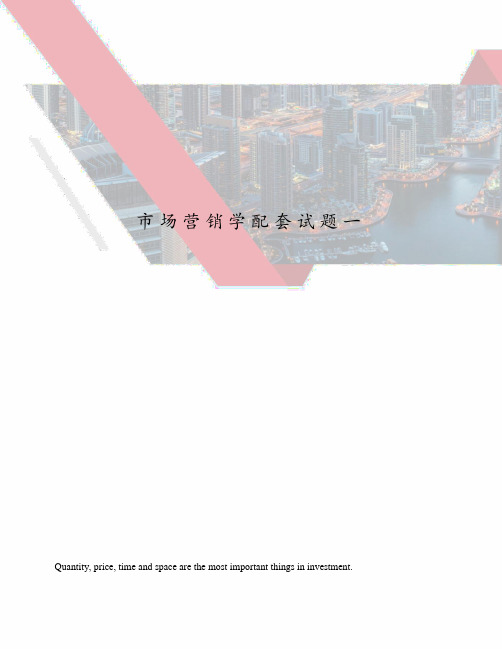
市场营销学配套试题一Quantity, price, time and space are the most important things in investment.市场营销学通论第七版配套试题一一、名词解释任选5小题回答,每小题4分,共20分1 产品观念2 渗透定价3 密集分销 4人员推销 5市场营销管理6 新产品采用7 产品组合8 战略计划过程9 复杂型购买行为二、简答题任选3小题回答,每小题10分,共30分1 简述在产品生命周期成长期和成熟期企业应采取的营销策略;2 简述差别定价的主要形式及其适用条件;3 简述服务营销组合的构成要素以及服务的特征;4 简述在不同需求情况下营销管理的任务;5 简述品牌忠诚度的资产价值及其测量方法;6 简述影响促销组合的因素;三、论述题任选1小题回答,20分1 联系实际论述目标市场涵盖战略以及选择涵盖战略时需考虑的主要因素;2 联系实际,论述评价企业战略业务单位的GE法与BCG法的联系与区别;3 结合某企业的营销实践,论述促销工具类型以及影响企业促销策略的主要因素;四、案例分析题每小题10分,30分从NOTE7燃爆事件,看三星危机公关的得与失自2016年8月19日发售后,接连发生起火或爆炸事故的Galaxy Note 7手机以下简称Note 7成了三星的噩梦,其召回过程一波三折,三星一度认为是电池供应商的工程瑕疵导致Note 7事故频发;但为用户更换后的“安全版”Note 7仍然发生了数起自燃事故,之后欧美各大运营商和航空公司纷纷宣布抵制 Note7;此后三星在全球范围进行紧急召回了250多万部Note 7,并于11月7日在纽约时报、华尔街日报和华盛顿邮报等美国三大主流报纸上刊登了整版道歉声明,为爆炸的Note7道歉;而Note7在中国却成为例外,8月末的时候,关于三星Note7电池爆炸的消息开始蔓延,那个时候欧洲就开始召回,9月中旬,美国开始召回,但此时,三星依旧将中国市场排除在外;针对中国曝出的三星Note 7的爆炸案,三星电子的回应是与电池无关,因为大陆版Note 7采用的是香港Amperex而非Samsung SDI供应的电池,中国的电池供应商没有问题,因此没有必要在中国进行大规模召回;针对中国最早发生的两起Note 7爆炸事件,三星曾回收手机,并于9月19日与电池供应商ATL发布了调查结论,称手机爆炸与电池无关,是外部热源导致;并声明说是国人加热骗取赔偿,仍然坚持手机安全,拒绝召回;但因为这个结论由三星自己得出,其真实性遭外界质疑;9月29日,三星再次发声明,称第三方权威机构对燃损手机的检测显示,系外部热冲击导致的手机燃损;而据美国纽约时报网站10月19日报道,三星曾向中国曝光note7爆炸的当事人提出送一部新的Note 7手机,以及6000元人民币的赔偿,条件是他不公开视频,但被当事人拒绝了;12月2日,第三方机构Instrumental发布了关于Note 7电池爆炸的调查报告,表示电池爆炸是由手机本身的“激进设计”所导致的;认为Note 7手机内部的空间十分拥挤,电池与主板之间的距离非常窄,最窄处仅0.1mm;这使得Note 7的电池即使在日常使用中也会受到挤压,而压力会使电池正、负极的“分离装置”很容易损坏,正负接触会引发电池发热起火;三星的工程师在设计过程中极力加大电池体积,以此换取更大的电池容量;9月中旬,在国家质检总局约谈三星之后,三星开始召回在中国大陆地区销售的全部Note 7;而具体的召回方式中,消费者可以免费更换其它型号三星手机,会退还两个产品之间的差价,获赠300元购物券;而选择同样方式的美国消费者享受的优惠相当于670元人民币,韩国消费者可享受的优惠约合人民币595元;中国消费者也可以选择按购买价格全额退款,没有其它补偿;而同样的方式,美国消费者除了全额退款外,还可以获得约168元人民币的补偿,韩国消费者则可获得价值约198元人民币的优惠券;另据消费主张记者调查发现,在宣布召回和停止销售之后, Note7在北京市场仍然有售,三星虽然宣布了召回,但对召回细则迟迟不予出台,导致消费者仍然无法顺利退换;在经历了两个多月的纷纷扰扰后,三星电子终于在10月11日发布声明,在全球范围内停产、停售Note 7;10月13日, 韩国技术标准局确认Note7手机可能存在新的缺陷;这是三星note 7手机风波后来自韩国政企两界最明确的回应,也宣告了note7这款手机的彻底失败;到目前为止,中国消费者方面看到三星的道歉态度似乎只停留在9月底到10月初的官网弹窗的几个“道歉信”,还有10月底爆出的三星中国高管集体下跪的画面;三星中国公司的最新声明表示:对于给中国消费者带来的不便,再次表示真诚的歉意,三星电子坚守“做中国人民喜爱的企业,贡献于中国社会的企业”的承诺,秉持质量和服务第一的信念,为中国消费者带来最佳的产品和体验;央视曾就此发表评论,称贡献需要靠诚意,而不是傲慢;在全球召回近一个月后,才向中国消费者道歉的做法,缺乏诚意;作为世界最大智能手机制造商,这一事件给三星带来的品牌影响也不可估量,三星正在经历近几年来最大的危机;据数据统计,因本次事件已有超过50%的被调查消费者显示出对Note系手机开始产生坏印象的倾向;10月11日,三星电子股价再次暴跌8%,创2008年10月24日以来最大单日跌幅,市值蒸发170亿美元约合人民币1142亿元;问题30分,每小题10分:1、如何评价三星的这次危机公关你认为企业在关注经济利益的同时,如何成为一家有社会责任感的公司;2、结合案例,论述在追求快人一步,产品快速迭代的今天,企业在制定产品策略时应注意的问题;3、结合案例,论述企业应如何有效地开展危机公关;参考答案:一、名词解释1 产品观念:产品观念指消费者最喜欢高质量、多功能和具有某种特色的产品,企业应致力于生产高附加值产品,并不断加以改进,这种观念产生于市场产品供不应求的“卖方市场”形势下;2 渗透定价:渗透定价是指企业将其创新产品的价格定得相对较低,以吸引大量顾客,提高市场占有率;3 密集分销:密集分销是指生产者尽可能地通过许多负责任的、适当的批发商、零售商推销其产品;4人员推销:企业通过派出销售人员与一个或一个以上可能成为购买者的人交谈,作口头陈述,以促进和扩大销售;5市场营销管理:市场营销管理是指为了实现企业目标,创造、建立和保持与目标市场之间的互利交换关系,而对设计方案进行的分析、计划、执行和控制;6 新产品采用:新产品采用过程,是指消费者个人由接受创新产品到成为重复购买者的各个心理阶段;7 产品组合:产品组合,是指某一企业所生产或销售的全部产品大类、产品项目的组合;8 战略计划过程:战略计划过程,是指企业的最高管理层通过制定企业的任务、目标、业务组合计划和新业务计划,在企业的目标、资源、能力与迅速变化的经营环境之间发展和保持一种切实可行的适应战略的管理过程;9 复杂型购买行为:复杂型购买行为是一种对于品牌差异大的产品,广泛收集相关信息,慎重选择,仔细比较后才购买,以求降低风险的购买行为类型;二、简答题1 简述在产品生命周期成长期和成熟期企业应采取的营销策略;要点提示:成长期市场营销策略:改善产品品质;寻找新的子市场;改变营销沟通的重点;在适当的时机,可以采取降价策略,以激发那些对价格比较敏感的消费者产生购买动机和采取购买行动;成熟期市场营销策略:调整市场;调整产品;调整营销组合;2 简述差别定价的主要形式及其适用条件;要点提示:差别定价主要有四种形式:顾客差别定价、产品形式差别定价、产品部位差别定价、销售时间差别定价;差别定价的适用条件:1.市场必须是可以细分的,而且各个市场部分表现出不同的需求;2.以较低价格购买某种产品的顾客不可能以较高价格把这种产品倒卖给他人;3.竞争者不可能在企业以较高价格销售产品的市场上以低价竞销;4.细分市场和控制市场的成本费用不得超过因实行价格歧视而得到的额外收入;5.价格歧视不会引起顾客反感、放弃购买,进而影响销售;6.采取的价格歧视形式不能违法;3 简述服务营销组合的构成要素以及服务的特征;要点提示:服务市场营销组合:7P,即产品、价格、渠道、促销、人员people、有形展示physical evidence和过程process;服务的特征:无形性、相连性、易变性和时间性;4 简述在不同需求情况下营销管理的任务;要点提示:根据需求水平、时间和性质的不同,可归纳出八种不同的需求状况;在不同的需求状况下,市场营销管理的任务有所不同:在负需求的情况下,市场营销管理的任务是改变市场营销;在无需求情况下,市场营销管理的任务是刺激市场需求;在潜伏需求的情况下,市场营销管理的任务是开发市场需求;在下降需求的情况下,市场营销管理的任务是重振市场需求;在不规则需求的情况下,市场营销管理的任务是协调市场需求;在充分需求的情况下,市场营销管理的任务是努力维持市场需求;在过量需求的情况下,市场营销管理的任务是降低市场需求;对于有害需求,市场营销管理的任务是反市场需求;5 简述品牌忠诚度的资产价值及其测量方法;要点提示:品牌忠诚度是顾客对品牌感情的量度,反映出一个顾客转向另一个品牌的可能程度,是企业重要的竞争优势,是一种战略性资产,能够帮助企业:降低营销成本;增强渠道谈判力;吸引新顾客;减少竞争威胁;品牌忠诚度的测量方法:顾客重复购买次数、顾客购买挑选时间、顾客对价格的敏感程度、自愿搜寻;6简述影响促销组合的因素;要点提示:产品类型、推式与拉式策略、促销目标、产品生命周期阶段、经济前景;三、论述题1 联系实际论述目标市场涵盖战略以及选择涵盖战略时需考虑的主要因素;要点提示:企业在确定其目标市场涵盖战略时,有三种选择,即无差异市场营销、差异市场营销和集中市场营销;企业在选择涵盖战略时需考虑的主要因素包括:企业资源、产品同质性、市场同质性、产品所处的生命周期阶段、竞争对手的目标市场涵盖战略;结合要点展开论述分析,并联系实际,条理清晰,有理有据即可;2 联系实际,论述评价企业战略业务单位的GE法与BCG法的联系与区别;要点提示:企业在安排业务组合的过程中还要对各个战略业务单位的经营效益加以分析、评价,以便确定哪些单位应当发展、维持、减少或淘汰;最着名的分类和评价方法是BCG方法和GE法;波士顿矩阵法BCG就是用“市场增长率—相对市场占有率矩阵”来对其战略业务单位加以分类和评价,它将企业所有的战略业务单位分为四种不同类型:问号类、明星类、现金牛类和瘦狗类;通用电气矩阵法GE;通用电气公司的方法较波士顿咨询集团的方法有所发展;它用“多因素投资组合矩阵”来对企业的战略业务单位加以分类和评价,除了要考虑市场增长率和市场占有率,还要考虑许多其他因素;这些因素可以分别包括在行业吸引力和业务力量两个主要变量内;结合要点展开论述,并联系实际,条理清晰,有理有据即可;3 结合某企业的营销实践,论述促销工具类型以及影响企业促销策略的主要因素;要点提示:企业常用的促销工具包括广告、人员推销、销售促进以及公共关系等;促销组合是指企业根据促销的需要,对广告、销售促进、推销与公共关系等各种促销方式进行的适当选择和综合编配;影响企业促销组合的因素则包括产品类型、推式与拉式策略、促销目标、产品生命周期阶段以及经济前景等;结合要点展开论述,并联系实际,条理清晰,有理有据即可;四、案例分析题1、如何评价三星的这次危机公关你认为企业在关注经济利益的同时,如何成为一家有社会责任感的公司;要点提示:结合公共关系内容进行评价;对企业社会责任,可从产品质量、绿色营销、社会责任、企业道德等方面进行展开;2、结合案例,论述在追求快人一步,产品快速迭代的今天,企业在制定产品策略时应注意的问题;要点提示:可从产品概念构成及优化调整、产品生命周期及对应策略等内容,结合案例进行分析,有理有据即可;3、结合案例,论述企业应如何有效地开展危机公关;要点提示:结合公共关系的相关内容,可从信息监测、舆论宣传、协调沟通、危机处理等方面结合案例进行分析,有理有据即可;。
案例1谁的方式更有效

案例 1 谁的方式更有效高明是一位空调销售公司的总经理。
他刚接到有关公司销售状况的最新报告:销售额比去年同期下降了 25 %、利润下降了 10 %,而且顾客的投诉上升。
更为糟糕的是,公司内部员工纷纷跳槽,甚至还有几名销售分店的经理提出辞呈。
他立即召集各主管部门的负责人开会讨论解决该问题。
会上,高总说:“ 我认为,公司的销售额之所以下滑都是因为你们领导不得力。
公司现在简直成了俱乐部。
每次我从卖场走过时,我看到员工们都在各处站着,聊天的、煲电话煲的,无处不有,而对顾客却视而不见。
他们关心的是多拿钱少干活。
要知道,我们经营公司的目的是为了赚钱,赚不到钱,想多拿钱,门儿都没有。
你们必须记住,现在我们迫切需要的是对员工的严密监督和控制。
我认为现在有必要安装监听装置,监听他们在电话里谈些什么,并将对话记录下来,交给我处理。
当员工没有履行职责时,你们要警告他们一次,如果不听的话,马上请他们走人……”部门主管们对高总的指示都表示赞同。
惟有销售部经理李燕提出反对意见。
她认为问题的关键不在于控制不够,而在于公司没有提供良好的机会让员工真正发挥潜力。
她认为每个人都有一种希望展示自己的才干,为公司努力工作并做出贡献的愿望。
所以解决问题的方式应该从和员工沟通入手,真正了解他们的需求,使工作安排富有挑战性,促使员工们以从事这一工作而引以自豪。
同时在业务上给予指导,花大力气对员工进行专门培训。
然而,高总并没有采纳李燕的意见,而是责令所有的部门主管在下星期的例会上汇报要采取的具体措施。
【教学功能】本案例既涉及对人的激励,又涉及领导行为模式、领导环境等内容,有利于学生更好地理解和掌握领导的行为理论、领导权变理论,可在讲授领导职能时选用。
案例分析关键词:领导行为理论、菲德勒的领导权变模型、领导生命周期理论【问题】1. 高总是一位()领导。
A. 专制型B. 民主型C. 放任型D. 中间型2. 高总对员工的看法是基于()。
A. 泰勒制B. 人际关系学说C.Y 理论D. 超 Y 理论3. 李燕对员工的看法属于()假设。
项目生命周期和项目管理过程概述(1).ppt

建设工程总承包的类型
项目管理模式是指项目管理公司为业主提供的项目管理服务工作。
2.3 项目管理模式-PM
PM模式
业 主
设计总包单位
施工总包单位
设计分包单位一
设计分包单位二
设计分包单位三
施工分包单位一
施工分包单位二
施工分包单位三
监理单位
PM单位
2004年7月16日《国务院关于投资体制改革的决定》:对非经营性政府投资项目加快推行“代建制”,即通过招标等方式,选择专业化的项目管理单位负责建设实施,严格控制项目投资、质量和工期,竣工验收后移交给使用单位。 西方工程代建制主要模式工程代建制最早起源于美国的建设经理制(CM制),即由业主委托建设经理人来负责整个工程项目的管理,包括可行性研究、设计、采购、施工、竣工试运行等工作,但不承包工程费用。建设经理作为业主的代理人,在业主委托的业务范围内以业主名义开展工作,如有权自主选择设计师和承包商,业主则对建设经理的一切行为负责。
典型项目的生命周期
典型项目的生命周期
项目的阶段
项目生命周期一般划分为四个阶段: 启动阶段(或定义阶段) 规划阶段(或计划阶段) 实施阶段(或执行阶段) 收尾阶段 (或交付阶段)
项目生命期
时间
开始
结束
起动阶段
中间阶段(一个或多个)
收尾阶段
资源投入水平
项目生命期的特点
项目生命期特征: 看表3-1
2.3.5 PFI模式
9、静夜四无邻,荒居旧业贫。。*** 10、雨中黄叶树,灯下白头人。。**** 11、以我独沈久,愧君相见频。。***** 12、故人江海别,几度隔山川。。**** 13、乍见翻疑梦,相悲各问年。。***** 14、他乡生白发,旧国见青山。。**** 15、比不了得就不比,得不到的就不要。。。***** 16、行动出成果,工作出财富。。*** 17、做前,能够环视四周;做时,你只能或者最好沿着以脚为起点的射线向前。。**** 9、没有失败,只有暂时停止成功!。*** 10、很多事情努力了未必有结果,但是不努力却什么改变也没有。。**** 11、成功就是日复一日那一点点小小努力的积累。。***** 12、世间成事,不求其绝对圆满,留一份不足,可得无限完美。。**** 13、不知香积寺,数里入云峰。。***** 14、意志坚强的人能把世界放在手中像泥块一样任意揉捏。**** 15、楚塞三湘接,荆门九派通。。。***** 16、少年十五二十时,步行夺得胡马骑。。*** 17、空山新雨后,天气晚来秋。。**** 9、杨柳散和风,青山澹吾虑。。*** 10、阅读一切好书如同和过去最杰出的人谈话。**** 11、越是没有本领的就越加自命不凡。***** 12、越是无能的人,越喜欢挑剔别人的错儿。**** 13、知人者智,自知者明。胜人者有力,自胜者强。***** 14、意志坚强的人能把世界放在手中像泥块一样任意揉捏。**** 15、最具挑战性的挑战莫过于提升自我。。***** 16、业余生活要有意义,不要越轨。*** 17、一个人即使已登上顶峰,也仍要自强不息。****
第一讲——憧憬人生成功

二、人生需求与人生价值 —人生需求是有规律的,实现人生价值是人的高层次需求。
1、渐进的人生需求层次
(1)人的需求是有层次区别的
马斯洛:“人是永远不能满足的动物。”
著名的人生需求理论,指出人的需 求由低级向高级推进,即从生理需求—— 安全需求——友爱和归属的需求——受尊 敬的需求——自我实现的需求。
(2)需求层次是渐进提高的
案例1:生存与尊重 案例2:尊重与干涉
实现人生价值
(1)什么是人的价值
每个人都想活得有价值,但什么是价值呢?价值 就是客体对主体的有用性。
(2)人的价值组成
人的社会价值就是个人对社会需求的满足。 自我价值是个人对自身需求的满足。个人通过努 力,满足自身的生理、物质和精神方面的需求,即自 我贡献和自我尊重。 人格价值是指社会对个人需求的满足,特指作为 人的权利、地位和尊严,人格价值人人平等。
涌现出的新职业:
金融工程师、网上主持人、网络警察、时尚观测员、职业生 涯指导顾问等。
(2)职业和职务的关系
职业是形容行业的名词,职务是形容地位的名词.比如教师.工人.歌手 这都是职业,而校长.经理.导演则是职务.他们的本质属性不同. 举个例子:你在一家公司里做IT,那你的职业是软件工程师,但你的职
人生发展与职 业生涯 规 划
憧憬成功人生
主讲:李敏 华南农业大学 E-mail: minli21@
一封来信引发的思考
反映的几个问题 1、工作问题 2、研究生问题 3、爱情问题 4、发展问题 5、“本”“硕”问题
不知道自己是迷惑还是清醒 谜谜糊糊的觉得自己很迷惑 谜谜糊糊的以为自己很清楚 非常清楚的知道自己很迷惑 非常清醒的知道自己很清楚.
三一重工案例分析(一半)

三一重工案例分析摘要:三一重工股份有限公司(以下简称三一重工)是一家工程机械制造企业。
由于缺少一个清晰、明确的融资策略,三一重工在融资过程中存在许多问题和障碍,这严重制约了公司的长远发展。
无论从企业自身的发展目标,还是从行业发展前景来看,科学的融资策略可避免企业高速发展带来的财务危机,因此,研究三一重工的融资策略有助于三一重工的可持续发展,可以实践和丰富现代企业融资理论和可持续发展理论,是三一重工落实科学发展观的有益探索和努力,同时对其他上市公司也有一定的借鉴意义。
关键词:融资策略;内源融资;外源融资一、三一重工基本情况介绍三一重工股份有限公司(简称三一重工)是一家工程机械制造企业。
注册资金148,800,0000元人民币。
总部位于湖南省长沙经济技术开发区。
上市时间为2003-07-03,发行数量6000万股。
2009年,三一集团实现销售209.36亿元,三一重工主营业务收入137.45亿。
2008年,三一集团实现销售135.02亿元,三一重工主营业务收入91.44亿。
2006年,三一集团实现销售78.09亿元,三一重工主营业务收入52.10亿。
2005年,三一集团实现销售57.92亿元,三一重工主营业务收入25.37亿。
2004年,三一集团实现销售58.47亿元,三一重工主营业务收入9.27亿。
二、融资的必要性与紧迫性分析三一重工正处于快速发展和扩张时期,如何通过融资获得更多的资金来促进企业的发展显得越来越重要。
三一重工进行融资的必要性和紧迫性主要体现在以下六个方面。
1.融资是实现公司未来发展展望的保证工程机械行业近几年受国内和国际市场的拉动,一直保持快速增长势头,但从2009年三季度开始,受国际金融危机冲击影响,产品销售增幅明显回落,国际金融危机对工程机械行业滞后影响逐步显现。
从短期来看,我国工程机械行业将受到不利影响,但从长期形势来看,由于城镇化、工业化加速,我国工程机械行业长期向好格局将维持不变。
某水电站基于PDCA循环的工程质量管理案例分析(1)

某水电站基于PDCA循环的工程质量管理案例分析质量是工程本身的真正生命,也是社会关注的热点。
在科学技术日新月异和经济建设高度发展的今天,工程质量关系到国家经济发展和人民生命财产安全。
因此,工程质量至关重要,但是,在施工过程中,任何一个环节、任何一个部位出现问题,都会给工程的整体质量带来严重的后果。
因此,工程质量管理对于整个工程的建设和能否发挥应有的作用非常重要,论述基于PDCA循环的工程质量管理理念,对同类水电工程项目施工有着借鉴意义。
标签:PDCA循环;工程质量;计划1、PDCA工具分析PDCA是英语单词Plan(计划)、Do(执行)、Check(检查)和Action(行动)的第一个字母,PDCA循环就是按照这样的顺序进行质量管理,并且循环不止地进行下去的科学程序。
PDCA循环是全面质量管理所应遵循的科学程序。
全面质量管理活动的全部过程,就是质量计划的制订和组织实现的过程,这个过程就是按照PDCA循环,不停顿地周而复始地运转的。
2、工程概况某水电站为一等大型工程,以发电为主,兼有防洪、灌溉、旅游等综合利用功能。
水库正常蓄水位1134m,库容约20.72亿m3,电站装机容量3000(5×600)MW。
枢纽主要由挡水、泄洪排沙、电站引水系统及坝后厂房等建筑物组成。
引水发电系统建筑物布置在河中,岸边溢洪道布置在右岸台地里侧,导流明渠溢洪道布置在导流明渠位置。
3、工程特点、难点分析水电站左岸大坝在特殊干热河谷气候,昼夜温差大条件下进行碾压混凝土施工,温控质量要求高;工程规模大、地质条件差、基岩渗水量大、基础处理难度大、混凝土工程量大、防洪标准高、工期短;施工布置复杂、紧凑,对工程施工质量、施工安全、环境保护及与相邻标协调等提出了较高的要求。
该水电工程截流难度大、水力学指标高;地质条件差,基坑开挖、基础处理、设备安装工程量大,地质条件复杂导致二次开挖量、基坑渗水量大,工期控制难度大;特殊干热河谷气候、昼夜温差大条件下碾压混凝土连续浇筑强度高,导致质量控制难度大,混凝土施工道路布置困难,混凝土工程量大,施工强度高,持续时间长,温控要求高,保温被覆盖时间持续长,混凝土施工受气候影响较大;4、质量管理计划针对以上工程质量管理的特点和难点,项目部在制定质量管理计划时制订了本工程质量管理的实施原则:加强质量体系建设,确保体系运行良好;健全规章制度,规范程序管理;提高质量意识,注重培训实效;加强过程控制,确保实物质量;注重质量成果,积极开展“创优争先”。
第三章果树的生命周期和年生长周期[1].ppt.Convertor
![第三章果树的生命周期和年生长周期[1].ppt.Convertor](https://img.taocdn.com/s3/m/aa13fb0d59fb770bf78a6529647d27284b7337d7.png)
第三章果树的生命周期和年生长周期[1].ppt.Convertor第三章果树的生命周期和年生长周期1第一节果树的生命周期一、果树生命周期的意义1、概念:种子植物在其个体发育过程中,都要经历萌芽、生长、结果、衰老、死亡这一过程,这个过程包含了全部的生命活动,因此称之为生命周期。
2、实生果树生命周期又细分为:胚胎(胚胎形成至种子成熟)、幼年阶段、成年阶段和衰老阶段。
图2-1 苹果实生树阶段发育模拟图23、实生苗的阶段变化:树冠上部:枝,叶,芽表现栽培性状——阶段发育深阶段年龄大。
阶段发育特征树冠下部:表现幼年和野生性状——叶片薄,多刺等。
4、无性繁殖苗(营养苗):没有真正的幼年阶段,只有以营养生长为主的幼树阶段,这一阶段通常称为营养生长阶段,也叫幼树期。
5、了解生命周期的目的:⑴缩短童期或营养生长阶段,⑵延长成年阶段,⑶推迟衰老期的出现。
3二、实生树的生命周期(一)实生树:实生树是由种子萌发长成的果树个体。
这种树在一生中经历萌发与生长、多次开花与结果、衰老和死亡的完整历程。
从栽培实用出发,可将实生树个体发育的生命周期划分为幼年阶段、成年阶段和衰老阶段。
4(二)生命周期:1. 幼年阶段:①童期:幼年阶段也称童期,是指从种子萌发起,经历一定的生长阶段,到具备开花潜能这段时期。
童期长短是植物的一种遗传属性。
与栽培技术也有关。
②性成熟:实生果树经童期逐渐具备形成性器官的生理基础和能力并最终实现开花的过程,称为性成熟。
5(2)果树童期的特点:①是植物的一种遗传属性,又受栽培条件的影响。
②形态特点:枝条直立生长,密集且分枝角大,具针刺或针枝,芽小,叶薄。
③解剖特点:枝条木质部发达导管较少;叶片表皮细胞大,单位面积气孔少,栅栏组织和叶脉不发达,属典型耐阴结构。
6无性繁殖能力:扦插成活率:童年区枝条高于成年区枝条,1年生实生苗的枝条>2年生实生苗的枝条>成年树。
根系扦插:靠近根颈的根易于生根,远离根颈的根难于生根和长出枝条。
《资源枯竭型城市的转型发展(第1课时)》教学设计【高中地理(新课标)选必修2】

《资源枯竭型城市的转型发展》教学设计第1课时教学目标1. 运用典型案例,从区域的视角,认识分析资源型城市的发展周期,说明资源型城市生命周期发展与自然资源的关系,判断该资源型城市所处的生命周期位置。
(区域认知、综合思维)2. 通过典型案例,说出资源枯竭型城市的主要特征,综合分析该城市发展的方向。
(区域认知、综合思维)重点难点【教学重点】说出资源枯竭型城市的主要特征,分析资源枯竭型城市的发展方向,并归纳方法,能够迁移应用。
【教学难点】学会资源枯竭型城市的归纳方法,迁移应用。
教学过程【课程引入】播放视频“阜新市的转型发展之路”阜新市因煤炭资源丰富,曾被称为“煤电之城”。
我国第三套人民币的5元券背面图案中;左侧的煤炭开采图的原型就是取自阜新市海州露天煤矿,可见阜新市昔日的辉煌。
20世纪末,阜新市开始转变以煤电为主的经济结构。
出示图片“第三套人民币的5元券图案”师:那么,阜新市为什么要转型?阜新市的发展方向是什么?带着这两个问题,我们一起学习第二章第三节“资源枯竭型城市及其转型发展”。
(板书)第二章资源、环境与区域发展第三节资源枯竭型城市及其转型发展【讲授新课】出示图片“人地关系图”师:请大家据图说明自然资源与人类生产生活有着怎样的关系?生:(可能的答案)人类获取自然资源满足自身生存和发展所需。
(板书)一、资源枯竭型城市及其转型 1. 自然资源与人类社会的关系师点拨:地球为人类提供了生存和发展的环境,自然资源也是自然给人类的馈赠,人类通过不断地从自然界中获取自然资源,并把它转化为消费品以满足自身的生存和发展需求。
我们知道,自然资源在地球上是分布不均的,正是因为这种不均衡,使得一些资源丰富的地区能够以自然资源的大规模开采和初加工为主导产业而发展起来,例如发展钢铁工业、有色冶金工业等,这样的城市,就叫资源型城市。
出示图片“中国主要能源矿产分布图”师:请大家读图,任选一个你熟悉的城市,说出它是依托哪种自然资源而发展的?生:任选一个城市,并读图说出其依托的主要自然资源(学生讨论)。
生命周期视角下的金字塔底层创新策略选择:一个多案例研究

生命周期视角下的金字塔底层创新策略选择:一个多案例研究仝允桓;邵希;陈晓鹏【摘要】The Bottom of Pyramid ( BoP) represents the underserved low-income group disconnected from the global economy. This group contains a large number of unused capitals, such as human resource. Enterprises can effectively use these resourcesto help BoP group improve their income and remove poverty issues. In return, enterprises can obtain these hard-to-imitate resources. Previous BoPstudy focuses on developing business models to integrate BoPas an important customer segment. This paper investigates business models by integratingBoP as a providerbecause the arrangement is more relevant in China context. BoPgroup can be categorized by different activities; capability, recognition and external environment. Different challenges are associated with different activities, which requirean enterprise to exploit different innovation strategies at different stages of a business life cycle. This paper adopts the multi-case study method to investigate business activitiesthatintegrateBoP group as resources providers. This paper analyzes different challenges that enterprises face at different stages of the business life cycle. Furthermore, this paper offers some innovation strategies to help an enterprise find solutions tothese challenges and promote business activities at different stages of a life cycle. As a theoretical study, this paper proposestheoretical assumptions from existing research in the first part, and tests these theoretical assumptions with five BoP-related cases in the second part.The empirical results lead to the following conclusions:1. Enterprises will face specific challenges in business activities consideringBoP group as resource providers. These challenges include dealing with the cognitive characteristics of BoP group, establishing a trust relationship with BoP group, achieving economies of scale and high production efficiency, adjusting the technology and production process, enhancing the trade capacity, and becomingsocially embedded. These business challenges are caused by the characteristics of BoP groups, including capacity characteristics, cognitive characteristics, and external environment characteristics. Enterprises must address these specific business challenges when integrating BoP group as resources providers to create values.2. Enterprises face different challenges in different stages of development. In the start-up stage, the major challenge is cognitive characteristics of BoP group. In the growth stage, enterprises focus on how to improve production efficiency and reduce production costs to achieve economic feasibility. In the mature stage, enterprises need to consider how to obtain continuing profitable growth and keep long-term competitive advantages by innovation activities.3. Enterprises can address innovation challenges for the BoP groups with three strategies; optimize the value proposition, optimize the cost structure, and improve scalability. When identified with the value proposition provided by enterprises, BoP groups are willing to participate in the process of value creation and provide enterprises with their own inherent resources. In order to optimize the cost structure, an enterprise needs to build anappropriate cost structure to improve economic viability by redefining the value network. To improve scalability enterprises need to provide a solution for long-term sustainable development.4. Enterprises should focus on various innovation strategies to address different business challenges in different stages of development. When an enterprise evolves from the start-up to the growth and then to the mature stage, the adopted innovation strategy should be able to optimize the value proposition, fine-tunecost structure, andimprove scalability, respectively.%金字塔底层(BoP)群体意指与全球化经济相脱离、未能分享经济成长成果的低收入群体,群体中蕴含着大量未被运用的人力资源和其他资本.如果BoP群体中的这些资源能够被企业有效利用,一方面可以帮助BoP群体提高收入,摆脱贫困,另一方面可以帮助企业获得难以模仿的资源优势和效率优势.由于BoP群体在能力特征、认知特征及所处的外部环境方面与成熟经济中的其他群体有很大区别,企业以BoP群体作为资源提供者时会面临一些特定的挑战.这些挑战与企业所处的生命周期阶段相关,不同发展阶段的企业所关注的商业挑战重点不同,从而导致企业在不同的发展阶段需要采用不同的创新策略.因此,本文运用多案例研究方法对BoP群体作为资源提供者的企业进行研究,分析其在不同发展阶段面临的商业挑战,并针对不同商业挑战制定出相应的创新策略,帮助开展BoP群体作为资源提供者的商业活动,以真正解决贫困问题.【期刊名称】《管理工程学报》【年(卷),期】2011(025)004【总页数】8页(P36-43)【关键词】金字塔底层;创新策略选择;生命周期;贫困【作者】仝允桓;邵希;陈晓鹏【作者单位】清华大学经济管理学院,北京100084;清华大学经济管理学院,北京100084;国家开发银行,北京100032【正文语种】中文【中图分类】F2730 引言社会经济金字塔底层(BoP)意指发展中国家中与全球化经济相脱离、未分享经济成长成果的低收入群体。
项目管理讲义(第1章--第11章)

新药 申请
注册后 活动
代谢作用 毒性研究
专利处理过程
发现 筛选
临床前研究 10年以上
病情登记
项目管理过程的内容
项目管理过程的特点 项目生命周期与项目管理过程的关系
1、项目管理过程的内容
启动
规划
监控各过程 规划各过程
42个 过程
执行
命周期。
丁荣贵认为:项目生命周期就是由完成项目需要
经过的若干个不同阶段或过程组成的总体。
二、项目生命周期的一般划分
启动 组织与准备 项目 成 本 和 资 源 投 入 水 平 项目管理 的输出 项目章程 项目管理计划 时间 验收的可 交付成果 存档的 项目文件
执行工作
结束项目
图2-1 项目通用的生命周期结构
多变的资源需求
效果型的 风险和不确定型的
稳定的资源需求
效率型的 经验型的
四、项目的分类
按项目规模分类:大型项目、中型项目和小型项目 按项目的复杂程度分类:复杂项目和简单项目 按项目的结果分类:产品型项目和服务型项目
按行业分类:工业、农业(林业)、IT业、水利项目…
按项目进展领域分类:科研项目、工程项目、产品开
21世纪
2002年4月,中国(首届)项目管理国际研讨会于北京召开,并 出版了《中国项目管理知识体系纲要》
二、项目管理的起源和发展(续)
3、项目管理的发展趋势: 项目管理的应用范围扩大
从偏重技术管理到关注人的管理
项目管理被作为组织结构扁平化的解决方案
三、项目管理很难做好
项目管理箴言:
发项目……
盈利项目和非盈利项目 从不同层面分
四、项目的分类(续)
产品生命周期管理 (1)-思维导图
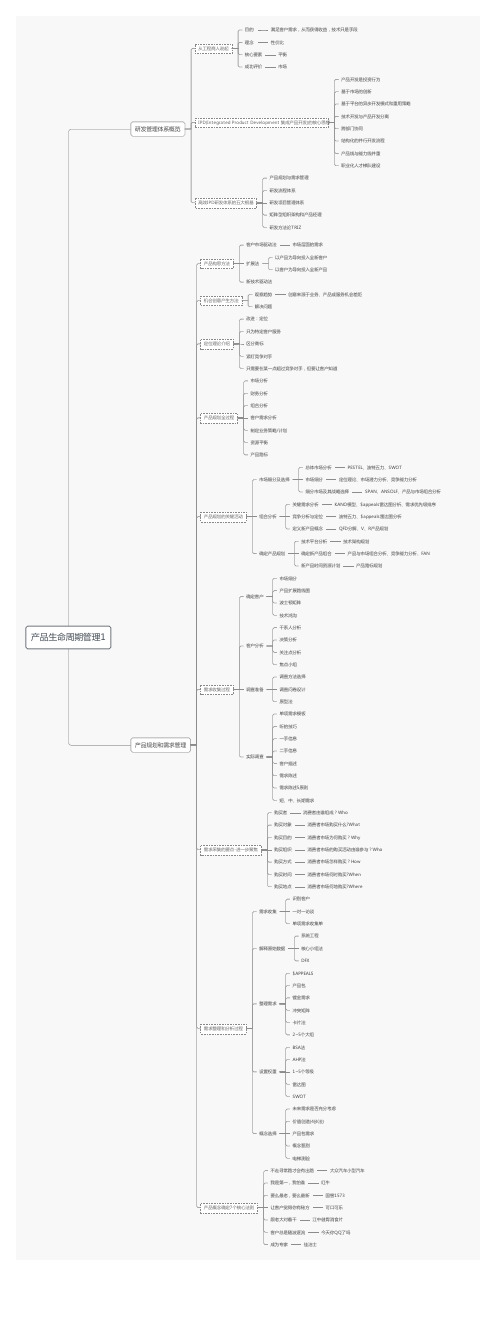
消费者市场何地购买?Where
识别客户
需求收集
一对一访谈
单项需求收集单
系统工程
解释原始数据
核心小组法
DFX
$APPEALS
产品包
整理需求
镀金需求 冲突矩阵
需求整理和分析过程
卡片法 2~5个大组
BSA法
AHP法
设置权重
1~5个等级
雷达图
SWOT
未来需求是否充分考虑
价值创造(4步法)
概念选择
产品包需求
概念甄别
结构化的并行开发流程
产品线与能力线并重
职业化人才梯队建设
产品规划与需求管理
研发流程体系
高效I PD研发体系的五大根基
研发项目管理体系
矩阵型组织架构和产品经理
研发方法论T RIZ
产品规划和需求管理
客户市场驱动法
市场层面的需求
产品构思方法
扩展法
以产品为导向投入全新客户 以客户为导向投入全新产品
新技术驱动法
市场细分
定位理论、市场潜力分析、竞争能力分析
细分市场及其战略选择
SPAN、ANSOLF、产品与市场组合分析
关键需求分析
KANO模型、$a ppe a ls 雷达图分析、需求优先级排序
产品规划的关键活动
组合分析
竞争分析与定位
波特五力、$a ppe a ls 雷达图分析
定义新产品概念
QFD分解、V、R产品规划
产品生命周期管理1
研发管理体系概览
目的
满足客户需求,从而获得收益,技术只是手段
从工程商人说起
理念
性价比
核心要素
平衡
成功评价
市场
循环经济在产品设计中的创新思维与方法
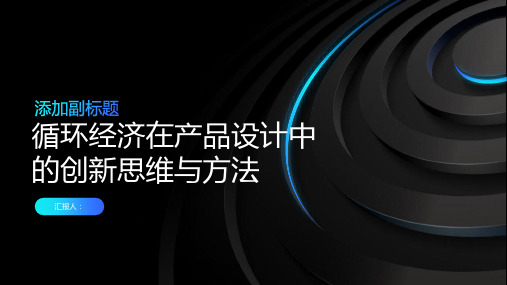
在循环经济中的运用:通过模块化 设计,使产品更容易拆卸、回收和 再利用
添加标题
添加标题
添加标题
添加标题
优点:提高产品的可维护性和可升 级性,降低制造成本和减少浪费
对环境的贡献:减少废弃物产生, 降低对环境的破坏
生命周期设计
定义:考虑产品全生命周期内的所有因素 目的:优化产品设计,提高产品的可持续性和环境友好性 考虑因素:功能需求、材料选择、制造工艺、使用与维护、回收与处理等 方法:系统化设计、模块化设计、面向拆卸设计等
基于用户反馈的产品设计优化
收集用户反馈:通过调查问卷、在线评价等方式收集用户对产品的反馈意见 分析用户需求:对收集到的反馈意见进行分析,了解用户对产品的需求和期望 产品设计优化:根据分析结果,对产品设计进行优化,提高产品的用户体验和功能性 循环迭代:根据用户反馈不断迭代产品,实现产品优化和升级
产品设计中的循环经济理念
目的:提高资源利用效率, 降低环境污染
方法:采用可再生材料、可 拆卸设计、绿色制造等
定义:将循环经济理念应用 于产品设计中
优势:延长产品生命周期, 减少浪费,降低对环境的影
响
循环经济产品设计的基本原则
资源化原则: 将废弃物转变 为可再利用的
资源
减量化原则: 减少产品的物 质使用量,优
技术创新:随着科技的不断进步,循环经济 产品设计将更加注重技术创新和研发,推动 新材料、新工艺、新能源等领域的创新应用。
政策支持:政府将加大对循环经济产品设计 的支持力度,推动相关法律法规的完善,促 进产业发展和模式创新。
市场需求:随着消费者对环保、健康的关注 度不断提高,循环经济产品设计将更加注重 满足市场需求,提高产品竞争力和附加值。
产品设计的持续改进与升级
- 1、下载文档前请自行甄别文档内容的完整性,平台不提供额外的编辑、内容补充、找答案等附加服务。
- 2、"仅部分预览"的文档,不可在线预览部分如存在完整性等问题,可反馈申请退款(可完整预览的文档不适用该条件!)。
- 3、如文档侵犯您的权益,请联系客服反馈,我们会尽快为您处理(人工客服工作时间:9:00-18:30)。
The usuage of renewable resources [see also “Renewable Resources”, glossary] will become more important in future. For being competitive, products made by refining these renewable resources have to be technically and economically equal to products made from petrochemical raw materials. In addition, they have to be more sustainable.
Credit items Within the study it was considered that intermediates are not produced in any affiliated location and that there is no usage of the waste heat. Credits were only considered for the production of acrylic acid because of the good database. There was also no bonus passed to the inventory’s credit for the
How was the Inventory Analysis drawn up?
In the following paragraph the details of drawing up an inventory analysis should be described more precisely. The time scope and the demands on the amounts of data could be demonstrated by it. The structure of the system was refined because of the fact that two different ways of manufacturing are compared to each other and those methods consist of varying steps. This procedure is explained in the following. Fine Structure of the System The system boundaries have been divided into the sectors “Linseed Oil Epoxide” and “Petrochemical coating binder” for drawing a comparison. Additional subdivisions depend on the logical order of the value-added chain of each system. The inventory section “Linseed Oil Epoxide” was subdivided into the sub-processes shown in Figure 3 according to the chain of economic value added.
2
Fig. 1: System of Coating Binders
Other predefinitions must be determined for selecting the inventory boundaries. They are described subsequently.
Cut-off Criteria (Limits of detail) No material flows were usually cut off in the presented study. All flows required for the interpretation have been observed and evaluated from entering to leaving the system boundaries if the database was sufficient.
Allocation The total process energy was allocated according to the proportion of the particular product in the total production. The emissions and disposals that result from the manufacturing were treated as well. They were prorated according to their share in the entire otilization of coupling products, but the possibility was pointed out.
Geographical and chronological reference The considerations refer to the political borders of the Federal Republic of Germany. If substances were provided in other countries (e. g. mineral oil) the country of origin has been chosen as reference weighed according to the particular market share of the substance in Germany. The year 1999 was selected as reference year for the views.
Life Cycle Assessment – Example 1
Why has this study been selected as an example?
The requirements of the Life Cycle Assessment method provided by the ISO/DIN 14040 et sqq. standards are sometimes difficult to understand. The study “Life Cycle Assessment of selected raw materials for paints: a comparison between vehicles based on renewable and petrochemical raw materials” was chosen to make the abstract statements of this norm more clearly. The study was carried out according to the ISO standard. Differently from this, the parts “Life Cycle Impact Assessment” as well as “critical review” were not included into the balance. Nevertheless, the necessary steps the Life Cycle Assessment method (without Impact Assessment) can be conceived within this example.
Fig. 1: parquet surface, sealed with UV-hardening varnishes
1
How were the general conditions defined?
The Aim of this Study The aim of the study was a holistic data entry of environmental impacts caused by the production of the coating binder linseed oil epoxide (Leinölepoxid, ELO) on the basis of the renewable material linseed oil. A petrochemical coating binder consisting of a mixture (50:50) of tripropylene glycol diacrylat (TPGDA) and bisphenol-A-diglycidetheracrylat (DGEABA) has been taken as reference.
The System boundaries of the Investigation According to the aim of a holistic examination all up- and downstream processes were considered. That means that the non-facility scopes of supplying raw materials and energy were also included in the examination. The material and energy flows emerging within the system boundaries were observed and inventoried usually from their withdrawal or to their releasing into the environment respectively. The environment serves as source (e. g. the removal of crude oil from the deposits) or as drain (e. g. CO2-emissions into the atmosphere) for material flows. The system boundary is defined as the gate of the manufacturer of the processible coating binder. The system boundary “gate” could be chosen because technical equivalence was assumed for the different products. That means there is no difference in usuage, disposal etc..
